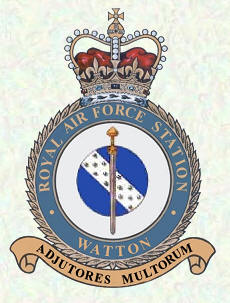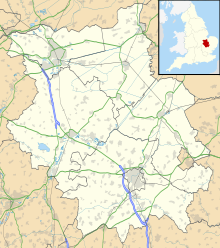
Royal Air Force Waddington otherwise known as RAF Waddington is a Royal Air Force (RAF) station located beside the village of Waddington, 4.2 miles (6.8 km) south of Lincoln, Lincolnshire, in England.

Royal Air Force Abingdon or more simply RAF Abingdon is a former Royal Air Force station near Abingdon, Oxfordshire. It is now known as Dalton Barracks and is used by the Royal Logistic Corps.

Royal Air Force Syerston, commonly known as merely RAF Syerston, is a Royal Air Force station in the parish of Flintham, near Newark, Nottinghamshire, England. Opened in 1940, it was used by the Royal Air Force (RAF) as a bomber base during the Second World War, operating Vickers Wellingtons, Avro Manchesters, and the Avro Lancaster heavy bombers. Post-war, it became home to Jet Provosts of the 2 Flying Training School. It is now home to the Royal Air Force Central Gliding School.

Royal Air Force Wyton or more simply RAF Wyton is a Royal Air Force station near St Ives, Cambridgeshire, England. The airfield is decommissioned and is now home to the Joint Forces Intelligence Group.
No. 8 Group was a Royal Air Force group which existed during the final year of the First World War and during the Second World War.

Royal Air Force Finningley or RAF Finningley was a Royal Flying Corps and Royal Air Force station at Finningley, in the Metropolitan Borough of Doncaster, South Yorkshire, England. The station straddled the historic county boundaries of both Nottinghamshire and the West Riding of Yorkshire.
Royal Air Force Foulsham, more commonly known as RAF Foulsham is a former Royal Air Force station, a military airfield, located 15 miles North-West of Norwich, in the English county of Norfolk, East Anglia, from 1942 to 1945.

Royal Air Force Upwood or more simply RAF Upwood is a former Royal Air Force station adjacent to the village of Upwood, Cambridgeshire, England, in the United Kingdom.

Royal Air Force Watton or more simply RAF Watton is a former Royal Air Force station located 9 mi (14 km) southwest of East Dereham, Norfolk, England.

Hunsdon Airfield is an airfield near Hunsdon, Hertfordshire and 2.8 miles (4.5 km) north of Harlow, Essex, England. As of 2021, it is used by a local microlight club.

Royal Air Force Bourn or more simply RAF Bourn is a former Royal Air Force station located 2 miles (3.2 km) north of Bourn, Cambridgeshire and 6.9 miles (11.1 km) west of Cambridge, Cambridgeshire, England.
Royal Air Force Thornaby or more simply RAF Thornaby was a former Royal Air Force Station located in the town of Thornaby-on-Tees, in the North Riding of Yorkshire, England. Fighter Command, Bomber Command and Coastal Command all operated from the base over its history, but its stint under Coastal Command is what the base was notable for, particularly in the air-sea rescue environment and the development of the Thornaby Bag. This was an emergency bag dropped to downed aircrew at sea and contained food, cigarettes and drink.
Royal Air Force Dunholme Lodge or more simply RAF Dunholme Lodge was a Royal Air Force station located between the parishes of Welton and Dunholme in Lincolnshire, England.
RAF Downham Market was a Royal Air Force station in the west of the county of Norfolk, England which operated during the second half of the Second World War.

RAF Graveley is a former Royal Air Force station located 5 miles (8 km) south of Huntingdon. The station was originally intended to operate under No. 3 Group RAF, alongside RAF Tempsford and RAF Gransden Lodge.
Royal Air Force Woolfox Lodge or more simply RAF Woolfox Lodge is a former Royal Air Force station next to the A1 road in Rutland, UK. The airfield is split between the parishes of Empingham and Greetham. It was open from 1940 until 1966.
Royal Air Force Catfoss or more simply RAF Catfoss is a former Royal Air Force station during the Second World War. It was located 4 miles (6.4 km) west of Hornsea, Yorkshire, England and 8 miles (13 km) north-east of Leconfield, Yorkshire, with the nearest village being Brandesburton.
No. 571 Squadron RAF was a Second World War Royal Air Force pathfinder squadron operating the de Havilland Mosquito.
Royal Air Force Tuddenham or RAF Tuddenham is a former Royal Air Force station located 3.2 miles (5.1 km) south east of Mildenhall, Suffolk, England and 7.8 miles (12.6 km) north west of Bury St Edmunds, Suffolk.

Royal Air Force Alconbury or more simply RAF Alconbury is an active Royal Air Force station near Huntingdon, England. The airfield is in the civil parish of The Stukeleys, close to the villages of Great Stukeley, Little Stukeley, and Alconbury. Flying operations are no longer based at the site, with most of the land, including the runway, having been sold in 2009 to become the new settlement of Alconbury Weald.












